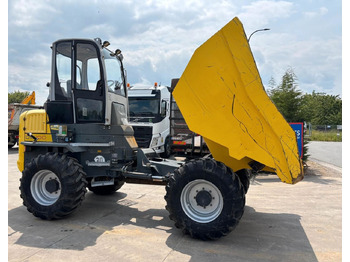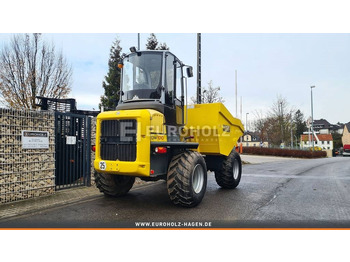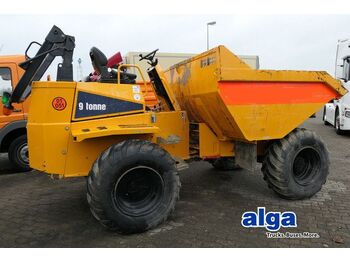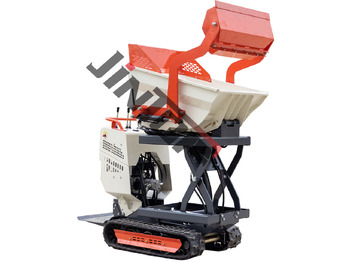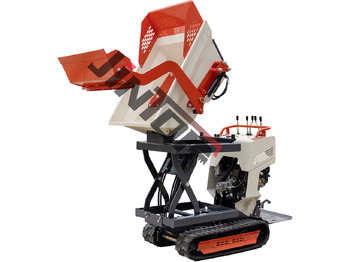Leasing 6.5HP Mini Dumper Small Dump Truck with lifting
Gepubliceerd: 16d.
Gepubliceerd: 16d.
 China, Shandong Province, China
China, Shandong Province, ChinaEngineModel: Briggs&StrattonPioneer
EngineType: Single cylinder, OHV, 4-stroke, air cooling
Displacement(ml): 203CC
RatedPower(kw/rpm): 6.5HP/3600rpm
FuelType: 92 #Gasoline
Fuel Tank capacity(L): 3.6
Total Weight(KG): 550
Maximum load(KG): 500
Machin size(Without pedal, without bucket)(MM): 1570*880*1450
Bucket size with foot pedal(MM): 2050*880*1450
Container size(MM): 1050*730*730
Chassis width(MM): 700
Maximum rise(MM): 1020mm
Tipping height(MM): 970mm
Tipping interval(MM): 220mm
track width(MM): 180
Track grounding length(MM): 1000
Chassis groundclearance(MM): 110
Cargo box Capacity(dm³): 200
Tipping Systme: HydraulicTipper
TiltingAngle(°): 100
Walking Speed(km/h): 2.88
Minimum Turning radius(MM): 1150
Track gauge(MM): 520
Climbing abillty(°): 20
1. Efficient Discharge and Adaptability to Complex Terrains
- Convenient Discharge: Through a hydraulic lifting system, the truck bed can be tilted to a specified angle (typically 40°–60°), allowing materials (such as sand, soil, construction waste, etc.) to be quickly unloaded by gravity. Compared with traditional trucks that require manual assistance for unloading, efficiency is improved by over 30%.
- Strong Terrain Adaptability: The lifting function adjusts the bed height, enabling precise control of the discharge position in uneven construction sites, slopes, or low-clearance spaces (e.g., underground garages, tunnels). This prevents material spillage or obstruction. For example, when building roads in mountainous areas, stones can be directly unloaded to designated areas by cliffs, reducing secondary handling. 2. Flexible Loading and Wide Load Range
- Multi-scenario Loading Capacity: The bed size and load capacity can be customized (common loads range from 5 to 30 tons), capable of carrying both bulk materials and large components (such as precast concrete blocks, steel) by adding fences. Some models also support detachable or foldable beds to adapt to different cargo types.
- High Space Utilization: The lifting function lowers the bed height, facilitating loading and unloading in low warehouses or containers. For instance, goods can be directly loaded from low loading docks into the bed, reducing forklift reliance and saving warehousing costs. 3. Safe Operation and Reduced Labor Intensity
- Automated Control: The hydraulic lifting system is operated via buttons or remote control, minimizing safety hazards (e.g., falls, material collapse) from manual climbing to unload, especially suitable for transporting hazardous materials like construction waste.
- Stability Design: The vehicle is equipped with anti-tip supports and a balancing system to maintain stability during lifting and avoid rollover risks. For example, when unloading on muddy construction sites, the supports can extend to the ground to enhance grip and ensure safe operation.
#### 4. Multi-functional Expansion and High Cost-effectiveness
- Integrated Additional Functions: Some models can be equipped with sprinkler systems (to reduce dust when transporting powdery materials), sealed tarpaulins (to prevent spillage), or weighing systems (to monitor load in real time), meeting environmental and metering requirements.
- Low Lifecycle Cost: Compared with the combination of a loader and a truck, a single lifting dump truck can complete multiple tasks such as "transportation + unloading + short-distance handling," reducing equipment procurement and maintenance costs, making it suitable for small and medium engineering teams.
Typical Application Scenarios of Lifting Dump Trucks
1. Construction Engineering and Infrastructure Development
- Construction Site Material Transportation: During building construction, transport concrete and bricks to the bottom of high-rise tower cranes, directly docking with the crane hopper via the lifting function; during road construction, unload asphalt materials in front of pavers for continuous paving operations.
- Earthwork Projects: Transport ores to crushing stations in mining, or precisely unload soil to designated areas during foundation backfilling, avoiding manual relaying.
2. Municipal Sanitation and Waste Treatment
- Garbage Collection: In urban waste transfer stations, lifting dump trucks can directly pour garbage from bins into the bed and unload it into compression equipment via the tipping function, reducing odor diffusion and environmental pollution from manual dumping.
- Municipal Construction: Transport sludge to treatment plants during sewer dredging; transport seedlings and fertilizers to green belts in landscaping, improving planting efficiency. 3. Agriculture and Animal Husbandry
- Agricultural Product Transportation: Transport grains and feeds on farms, with tipping discharge directly into granaries or livestock feeding troughs; during orchard harvesting, unload fruits onto sorting tables to reduce manual handling losses.
- Animal Husbandry Applications: Transport manure from farms to composting areas, with the lifting function adjusting the bed height to dock with manure treatment equipment for automated unloading.
4. Industry and Warehousing Logistics
- Factory Material Transfer: Transport slag in steel plants and cement clinker in cement plants, with tipping discharge directly into storage tanks; transport palletized goods in warehousing, where the lifting function adapts to shelves of different heights.
- Ports and Docks: Short-distance transport of containers or bulk goods (such as ores, coal), cooperating with cranes to complete ship loading and unloading operations and improving logistics turnover efficiency.
5. Special Scenario Applications
- Emergency Rescue: In disasters like earthquakes and floods, transport relief supplies to damaged road areas, with the lifting function enabling unloading beside obstacles (e.g., sandbags into riverbank gaps); during forest fires, transport fire-fighting equipment to rough mountain roads and quickly unload to fire points.
With the characteristics of "efficient unloading, flexible loading, and safe control," the lifting dump truck has become an important equipment in engineering, municipal, agricultural, and other fields. Its advantages not only lie in a single transportation link but also optimize the entire material handling process through functional integration, especially suitable for scenarios with high requirements for operational efficiency and terrain adaptability. When selecting a model, further refinement can be based on load requirements, terrain conditions, and additional functions (such as environmental configurations) to maximize equipment value.







